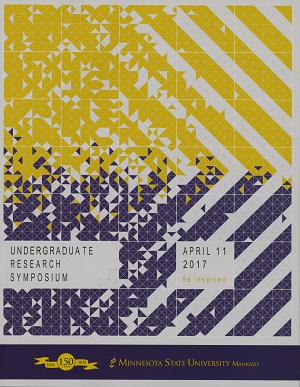Volume of Parasite Tissue Relative to the Volume of Host Tissue in Infected Snails
Location
CSU Ballroom
Start Date
11-4-2017 10:00 AM
End Date
11-4-2017 11:30 AM
Student's Major
Biological Sciences
Student's College
Science, Engineering and Technology
Mentor's Name
Robert Sorensen
Mentor's Department
Biological Sciences
Mentor's College
Science, Engineering and Technology
Second Mentor's Name
Scott Malotka
Second Mentor's Department
Biological Sciences
Second Mentor's College
Science, Engineering and Technology
Description
When trematode parasites infect snails they consume host tissue for asexual reproduction. For this study, snails were collected from Lake Winnibigoshish and checked for trematode infection. Infected snails were frozen for later use. These snails were then used to determine the volume of parasite tissue relative to the volume of host tissue in infected snails. This was accomplished by analyzing serial cross sections through the snails using light microscopy. First, the snails were washed in formalin overnight to fix the tissue and prevent degradation. The snails were then washed with distilled water and several baths of ethanol of increasing concentration. The ethanol washes gradually dehydrate the specimens to better preserve the tissue. Then the snails were washed with xylene. The snails were embedded in paraffin wax to allow for slicing in the microtome. Once the snails were cut into cross sections, the tissue was mounted on slides and stained using hematoxylin and eosin. The Moticam 10 digital camera was used to capture images of the slides under light microscopy. Moticam Images Plus software was used to calculate the volume of parasite tissue relative to the volume of host tissue in infected snails.
Volume of Parasite Tissue Relative to the Volume of Host Tissue in Infected Snails
CSU Ballroom
When trematode parasites infect snails they consume host tissue for asexual reproduction. For this study, snails were collected from Lake Winnibigoshish and checked for trematode infection. Infected snails were frozen for later use. These snails were then used to determine the volume of parasite tissue relative to the volume of host tissue in infected snails. This was accomplished by analyzing serial cross sections through the snails using light microscopy. First, the snails were washed in formalin overnight to fix the tissue and prevent degradation. The snails were then washed with distilled water and several baths of ethanol of increasing concentration. The ethanol washes gradually dehydrate the specimens to better preserve the tissue. Then the snails were washed with xylene. The snails were embedded in paraffin wax to allow for slicing in the microtome. Once the snails were cut into cross sections, the tissue was mounted on slides and stained using hematoxylin and eosin. The Moticam 10 digital camera was used to capture images of the slides under light microscopy. Moticam Images Plus software was used to calculate the volume of parasite tissue relative to the volume of host tissue in infected snails.
Recommended Citation
Adam, Ashley and Emily Jones. "Volume of Parasite Tissue Relative to the Volume of Host Tissue in Infected Snails." Undergraduate Research Symposium, Mankato, MN, April 11, 2017.
https://cornerstone.lib.mnsu.edu/urs/2017/poster-session-A/2



